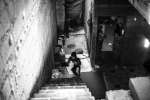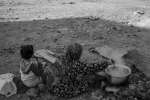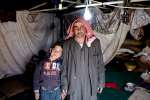- Text size
 |
|  |
|  |
| 
- Français
Food shortages trigger truancy in South Sudan camps
News Stories, 11 June 2014
GENDRASSA REFUGEE CAMP, South Sudan, June 11 (UNHCR) – Thirteen-year-old Mohamed Jaffir is one of hundreds of Sudanese children forced to pick the bitter leaves and twigs of the lofty lalop tree to supplement their family's food needs in the Gendrassa Refugee Camp.
The country around the camp in South Sudan's Maban County is dotted with lalop, or desert date, trees; children climb high and throw down young branches to smaller children on the ground, who pluck the tender leaves. Thousands have skipped school in the search for food in the county's four refugee camps.
A stone's throw away from Mohamed, his mother queues to receive a five-day ration of sorghum, lentils and oil. Experience in the camp has taught refugees here that those quantities will not last long. Wild leaves, roots and berries are a way to supplement meagre rations, especially during long stretches between food distributions.
Truancy has become a major problem as children sacrifice their education and spend their time picking the lalop leaves and berries, stripping fresh buds off baobab trees, and digging for roots in earth that has softened since the rains started. Though community leaders have been approached by UNHCR about regular school attendance, the response has been muted.
Mohamed says he uses the afternoon to collect leaves. His mother relies on him to care for his five younger siblings, ages ranging from two to 12 years, and to help put food on the table. Slim and wiry, he shows a bunch of twigs in his hand. "These are the ones the camels haven't nibbled on," he says, as he throws the twigs down. "Mother will cook them with the sorghum we will receive today."
The lalop tree is prevalent in the area and its leaves are edible but bitter. Some young children have stomach aches after eating them.
Osman Difala, an elder in the Gendrassa camp, is well known for his advocacy regarding the importance of education for refugee children and laments the current situation. "It is something we ourselves don't like to see, but without food the children cannot continue going to school," he says.
Any fall from the lalop trees, which are 15-23 metres high, could mean disaster for a child. Difala is distressed that children are being killed in falls from high trees. Two young children, both around eight years old, fell to their death recently in the Gendrassa and Kaya camps.
Others sustain injuries as they climb higher up the gnarled trunk to get to the leaves they're told to pick. Difala adds that some parents also send children back to the homes they fled from in neighbouring Sudan's fertile Blue Nile state to help cultivate family plots as safety nets against food shortages elsewhere.
Jockshan Foryoh, an education officer for UNHCR, says school enrolment is a major casualty of the food shortages in the four Maban refugee camps that house about 125,000 refugees.
"Since February this year, it has dropped to around 20,000 compared to the 30,000 students who registered last year," he says. For over a year Foryoh has steered UNHCR's interventions in education, including upgrading classrooms from tents to semi-permanent structures; providing stationery and textbooks; enrolling and training teachers; providing English-language courses; and issuing uniforms for almost all pupils in refugee schools.
"Food shortages are preventing children from attending school regularly. This is making a mockery of our efforts to promote child development and build their skills, capacity and resilience from early childhood through adolescence and young adulthood," says Foryoh. "If we're not able to keep children in school, 2014 will be a wasted year."
By Pumla Rulashe in Gendrassa Refugee Camp, South Sudan




































